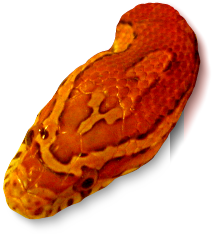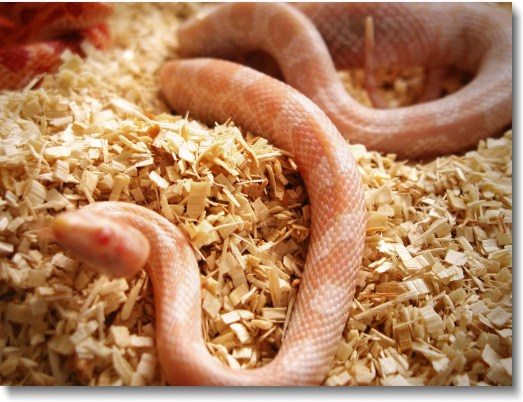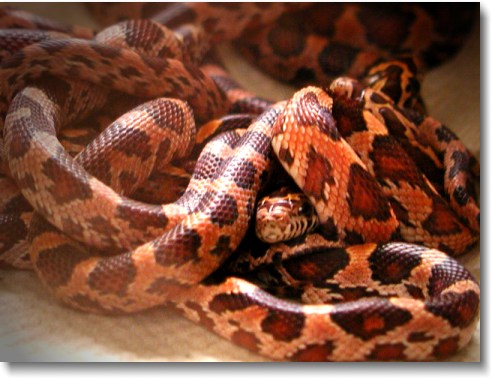Corn Snake
pictures and facts

Behavior
Corn snakes are very shy, and usually most active at night, however this varies with temperature. [22] In cold regions corn snakes will hibernate during the winter. But in warmer areas along the coast they will shelter in logs and rock crevices during cold days, and come out to soak up the heat of the sun on warm days. During the cold days, since snakes are less active they also need less food. [23] During the day they often hide under loose tree bark, beneath logs, rocks, and in rodent burrows where they search for their prey. Open forests, overgrown fields, and abandoned or seldom used buildings are their favorite haunts. Corn snakes are also accomplished climbers, able to scale vertical pine trees by clinging to the rough bark surface. [24] When threatened, corn snakes will often strike repeatedly while vibrating their tail. In dry vegetation the vibration of the tail is similar to the sound of a rattlesnake. This is sufficient to fool some predators (and humans) into thinking that they are a rattlesnake. In the first case, the predator is likely to leave the snake alone. However, in the second case the human is all to likely to kill the snake. It is worth noting that many people bitten by rattlesnakes were trying to kill the snake at the time, and not every snake that makes a rattling noise is a rattlesnake. [25] The best advice being to leave the snake alone unless it poses a real danger to people in the area. Even then, dealing with a rattle snake should only be attempted by someone with experience. [26] While corn snakes can be aggressive when they feel threatened, they can also be very docile in captivity, and even a wild corn snake can become tame quite quickly. [27]
The scales and pattern of a young snow corn snake.
Image Source: Photo taken by Corn Snake Pictures & Facts at the San Bernardino County Museum, with permission.
Available in two sizes:
1024 x 768 || 800 x 600
Habitat
The corn snakes natural range is from New Jersey, south to Key West along Florida's Atlantic seaboard, and then west to the Mississippi River around New Orleans. To the north there are several disjunct populations in Kentucky, central Louisiana, eastern Texas, extreme eastern Oklahoma, and Arkansas. [28] Corn snakes prefer terrestrial habitat, near pinelands, hardwood hemlocks, swamps, agricultural fields, and residential areas. [29] The sandy pine woods in the southeastern states have produced the most prolific concentration of corn snakes in the USA. Habitats that are relatively dry and exposed seem to be preferred, particularly in places with burrowing mammals. [30]
A baby corn snake peers out at the world.
Image Source: Photo taken by Corn Snake Pictures & Facts at the San Bernardino County Museum, with permission.
Available in two sizes:
1024 x 768 || 800 x 600
Natural Diet
Corn snakes swallow their food whole, usually beginning with the head. Their list of prey items include most any small lizard, rodent, or bird and their eggs, that are the same diameter, or close to the same diameter as the snake's body. [31] [32] Corn snakes are nonvenomous (although they do have teeth). Instead they kill their prey by first biting to obtain a firm grip then quickly wrapping one or more coils of their body around their victim, and squeezing tightly to suffocate the prey animal. Wild corn snakes like most other wild snakes will often go for days or weeks between meals. [33] Adult corn snake will predominantly feed on rodents; however, on occasion, they will take a bird or a bird's egg. [34]